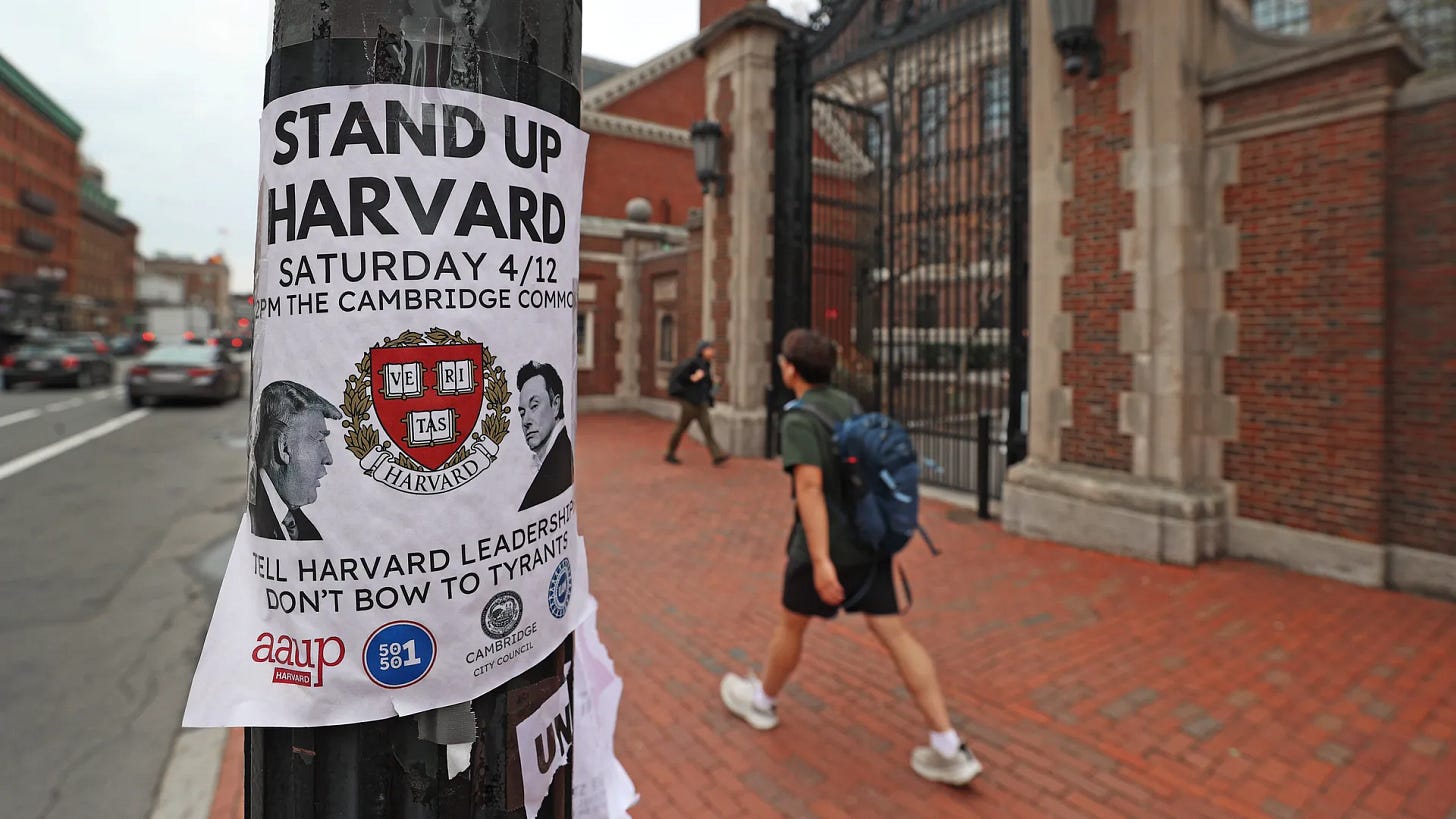A Harvard Epiphany (With a Little Help from Hillsdale)
The Administration has moved to cut Harvard's federal funding, which is teaching them a valuable lesson about taking govt. money.
Harvard University and Hillsdale College are both reputable institutions of higher learning located in the United States. They each have distinct educational missions and campuses that consist of buildings, students, and teachers/professors; but this is perhaps where the similarity ends. In many areas, such as age, size, geographic location, curriculum, ideas, strategy, and politics, the schools are quite different. Hillsdale College is known for its conservatism, devotion to religion, libertarianism, and its connection to the Republican Party. By contrast, Harvard University is not known for any of these things. But recently however, in one particular area of importance—money (i.e., funding)—Harvard and Hillsdale while previously worlds apart, surprisingly may now actually have something significant in common.
Hillsdale College
Founded in the Midwest in 1844 by Freewill Baptists from New England, and originally called Michigan Central College, Hillsdale College was the first American college to prohibit in its charter any discrimination based on race, religion, or sex. In the same year as its founding, women were admitted to the school making it the second oldest co-educational institution in the United States (Oberlin College in Ohio was the first in 1837). Black students were admitted immediately after the college’s founding in 1844. Because it opposed all forms of discrimination, Hillsdale attracted students of all Christian denominations, as well as Jewish students.
One attribute that has made the college truly unique is that as part of its overall financial strategy, it has consistently refused to take federal or state money (either from Democrat or Republican-controlled administrations), or any other funding that Hillsdale believes might potentially compromise its educational mission. Instead, it relies entirely on private donations to supplement the funds that it receives from student’s tuition.
This bold and unique position started with a decision not to participate in Eisenhower’s National Defense Student Loan Program and continued to harden in the late 1950s. In 1962 Hillsdale affirmed its stance against what it referred to as “government control,” and in the 1970s, Hillsdale gained national recognition for its withdrawal from federal and state-assisted student loan programs and grants.
Hillsdale College currently has approximately fifteen hundred undergraduate students and one hundred fifty postgraduate students, with a faculty of around two hundred. Its endowment totals around one billion dollars.
Harvard University
Harvard proudly owns the distinction as the oldest institution of higher learning in the United States. Founded in 1636 as New College, its name was changed to Harvard College in 1639 after its first benefactor, John Harvard, a Puritan clergyman. It did not become officially recognized as a university until 1780, the year when the Massachusetts Constitution went into effect. The University’s first black student to graduate from its halls was in 1870, but the school was not officially made coeducational until 1977 (that’s 1977, not 1877, just in case you might be thinking this is a typographical error). Harvard University has a storied history when it comes to Jewish students. One example is from 1922 when Harvard’s President, A. Lawrence Lowe III, proposed a quota limiting the number of Jews who could gain admission to the school.
With regards to financial strategy, Harvard depends on a degree of governmental funding to supplement the funds it receives from student’s tuition, and it annually receives significant amounts of both federal and state money. In 2024 alone, Harvard received almost seven hundred million dollars from the federal government.
Harvard University currently has around seven thousand undergraduate and fourteen thousand postgraduate students, for a total student body of approximately twenty-one thousand. Harvard has over two thousand faculty members, with an endowment of around fifty billion dollars.
A Wake-Up Call for Harvard
In 2023, Harvard received national attention after pro-Palestinian/anti-Israel student protests erupted on campus. During Congressional hearings which were held on the matter, former Harvard President Claudine Gay found herself unable to say before Congress whether calling for genocide against Jews violated any of Harvard’s rules or its Code of Conduct.
Pro-Palestinian/anti-Israel protests continued unabated on Harvard’s campus throughout 2024. As a consequence, the University was asked by the federal government to do more to curb these student protests, as it was seeking to ensure the safety of Harvard’s (in this case Jewish) students. The school responded that it would not be bullied into action and argued that such demands would impose “improper control” over the University. They also argued that such requests from the government violated Harvard’s Constitutional rights, specifically their First Amendment Rights (although exactly what specific rights under the First Amendment they are referencing is not entirely clear).
In response to this and other issues (such as Harvard’s DEI policies), the administration announced on May 5 that Harvard will no longer be eligible for any new federal grants.
As a result of the above developments, and in a surprising turn of events, it has become clear that Harvard may be slowly waking up to what Hillsdale College came to realize many years ago. Namely, that government funding—as does almost all forms of funding—often comes with strings attached. The realization currently being experienced by Harvard (with a little help from Hillsdale’s example) is that independence comes with a price. While it is true that “no-strings-attached” funding has always been universally preferred by almost all recipients in all situations, in the real world it cannot be expected—or demanded. Even if one is blessed for a period of time to receive no strings funding, it is certainly not a right.
A Valuable Lesson
A review of history and of the various details demonstrates that Harvard and Hillsdale have very little in common. But due to recent events, that may be changing.
So what do Harvard and Hillsdale now share?
The answer is at least a realization regarding the acceptance of government money. After many years of operations, Harvard, like Hillsdale, has finally come to appreciate that hundreds of millions of dollars in federal funding (or in Hillsdale’s case, some lesser amount) is no doubt a lot of money; but it is also a lot of strings.
Disclosure: the author is a graduate of Hillsdale College.
Photo Credit- appely. com, logify, Axios and The Boston Globe.







